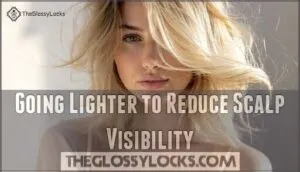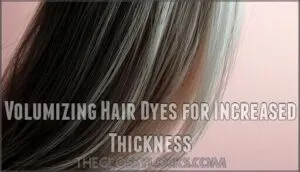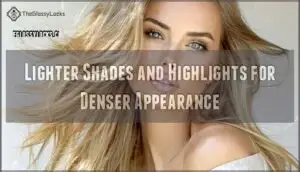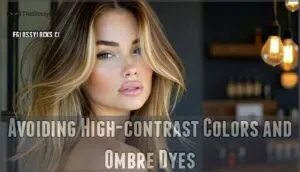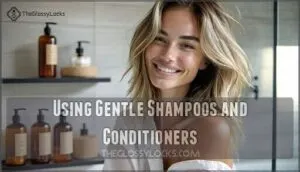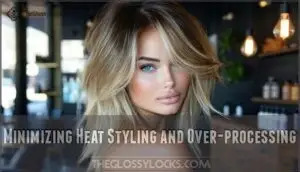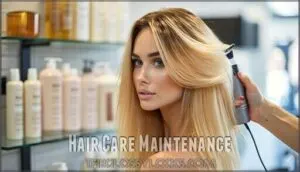This site is supported by our readers. We may earn a commission, at no cost to you, if you purchase through links.
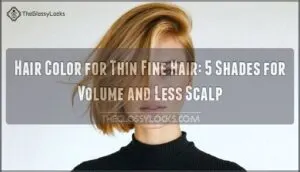 You’re not imagining things—the right hair color for thin fine hair can make your strands look twice as thick.
You’re not imagining things—the right hair color for thin fine hair can make your strands look twice as thick.
Lighter shades work like magic, reducing that pesky scalp visibility that makes fine hair appear even thinner. Think honey blonde or ash brown rather than jet black, which creates harsh contrast against your scalp.
Volumizing hair dyes actually deposit color particles that coat each strand, giving you fuller-looking hair from root to tip.
Subtle highlights add dimension and create the illusion of density, while avoiding high-contrast techniques like dramatic ombre that can emphasize thinning areas.
The secret lies in choosing colors that blur the line between hair and scalp.
Table Of Contents
- Key Takeaways
- Hair Color Techniques
- Best Hair Colors
- Gentle Hair Care
- Hair Care Maintenance
- Frequently Asked Questions (FAQs)
- What is the best hair color for thin hair?
- How to get a good hair color for thinning hair?
- How to color thin hair to make it look fuller?
- How to hide hair color for thinning hair on scalp?
- Is purple a good color for thinning hair?
- Should you color fine, thin hair?
- What hair color hides thinning hair best?
- How to make thin hair look fuller with color?
- What is the best haircut for very thin fine hair?
- How often should I touch up colored thin hair?
- Conclusion
Key Takeaways
- Choose lighter shades to create fuller-looking hair – You’ll want to go 1-3 levels lighter than your natural color, since lighter tones, such as honey blonde or ash brown, reflect light and reduce the harsh contrast between your hair and scalp that makes thinning more obvious.
- Use volumizing hair dyes that coat each strand – You can select specialized dyes with color particles that temporarily swell your hair strands, giving you a thicker appearance from root to tip without causing excessive damage to fragile hair.
- Add subtle highlights for dimension instead of high-contrast colors – You should avoid dramatic techniques, like bold ombre, that create harsh lines, and instead opt for strategic highlights or balayage that blur the line between hair and scalp.
- Maintain your color with gentle, sulfate-free products – You’ll need to switch to lightweight shampoos and conditioners that won’t strip your hair or weigh it down, and space your coloring sessions 6-8 weeks apart to prevent over-processing delicate strands.
Hair Color Techniques
Choosing the right hair color techniques can make thin, fine hair look fuller and more vibrant.
By using strategic shades and methods, you can minimize scalp visibility and add the illusion of volume.
Going Lighter to Reduce Scalp Visibility
Choosing a lighter hair color can work wonders for thin hair by minimizing scalp contrast and creating a fuller look.
Blonde benefits include reflecting light for added dimension.
Try these tips:
- Opt for shades 1-3 levels lighter than your base.
- Use highlights with strategic placement to blend naturally.
- Softer tones reduce scalp visibility effectively.
Volumizing Hair Dyes for Increased Thickness
Not all hair dyes are created equal, especially for thin or fine hair.
Volumizing hair color with specialized dye ingredients temporarily swells hair strands, creating a thicker appearance.
Avoid potential color damage by sticking to gentle application techniques catered for thin hair.
The key is to add dimension, since strategic shade placement substantially impacts perceived thickness.
Here’s a quick breakdown of options:
| Feature | Benefit | Concern |
|---|---|---|
| Volumizing Dyes | Temporary Swelling | Long-Term Effects |
| Thickening Formulas | Fuller Look | Requires Care |
| Gentle Ingredients | Reduced Damage | May Fade Faster |
The key to maintaining healthy hair while achieving the desired color is understanding the benefits and concerns of each option, and choosing the one that best suits your hair type, whether it’s volumizing dyes, thickening formulas, or gentle ingredients.
Lighter Shades and Highlights for Denser Appearance
By blending lighter shades and highlights, you can make thin hair look fuller.
Techniques like balayage create natural depth, while well-placed highlights break up the base color for softness.
Root shadowing adds dimension, complementing fine hair with subtle contrast.
Warm undertones like honey blonde or caramel tones reflect light beautifully, enhancing texture.
Blonde toning also guarantees brightness without harshness, and when combined with the right techniques, can create a natural depth that improves the overall appearance of thin hair.
Avoiding High-contrast Colors and Ombre Dyes
Brightening thin hair with highlights might’ve caught your eye earlier, but beware of stark contrasts that reveal more scalp.
High-contrast hair color, especially bold ombre styles, creates harsh lines, making thin hair appear sparser.
Instead, embrace Ombre Alternatives with soft color blending, and consider Dimensional color techniques that can also create the illusion of thicker hair, as seen in Dimensional color techniques.
Think warmth, not drama, and opt for natural shades close to your own, which reduce scalp visibility while adding dimension.
Best Hair Colors
When you’re dealing with thin, fine hair, choosing the right color products becomes essential for creating the illusion of fuller strands while protecting your hair’s delicate structure.
The following five hair color options have been specifically selected for their ability to add volume, reduce scalp visibility, and work gently with fragile hair types.
1. Clairol Root Touch Up Lightest Brown
Lightest brown offers the perfect compromise for thin hair that needs gentle coverage.
This root touch-up delivers 100% gray coverage in just 10 minutes, matching your existing color seamlessly with ColorBlend Technology.
You’ll get up to 3 weeks of lasting results between salon visits.
The permanent formula includes everything you need: brush, bowl, and gloves for easy application.
While some users find it slightly darker than expected, it’s an affordable solution that extends your color life by 2-4 weeks without damaging fragile strands, providing lasting results and gentle coverage.
Best For: Those looking for an affordable, quick, and easy root touch-up with 100% gray coverage and lasting results between salon visits.
- Provides 100% gray coverage in just 10 minutes.
- Affordable and includes all necessary tools for application.
- Lasts up to 3 weeks, seamlessly matching existing hair color.
- May turn out darker than expected for some users.
- Gloves included may not fit all users comfortably.
- Limited availability in stores, often found mainly online.
2. Loreal Paris Purple Shampoo for Blonde Hair
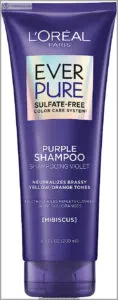
When you’re dealing with blonde hair that’s looking brassy, L’Oreal Paris Purple Shampoo steps up to save the day.
This sulfate-free formula neutralizes those unwanted yellow and orange tones that make thin hair look even thinner.
You’ll want to use it 2-3 times weekly for best results.
The hibiscus-infused formula keeps your hair moisturized while toning, which is essential for fine strands.
It’s gentle enough for color-treated hair and won’t strip your locks like harsher alternatives can.
Best For: Individuals with blonde, bleached, highlighted, or silver hair who want to neutralize brassy tones and maintain a cooler hair color.
- Sulfate-free, vegan formula that’s gentle on color-treated hair.
- Effectively reduces yellow and orange tones for a brighter appearance.
- Infused with hibiscus to hydrate and moisturize hair.
- May leave purple residue in the bathtub after use.
- Slightly drying for some users without a conditioner pairing.
- Mixed reviews on long-term toning effectiveness.
3. Schwarzkopf Dark Chocolate Brown Hair Color
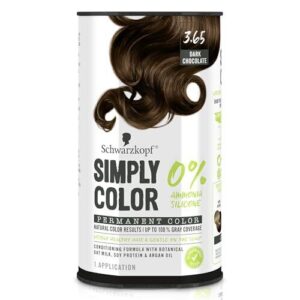 View On Amazon
View On Amazon You’ll find Schwarzkopf Dark Chocolate Brown delivers gentle color that won’t compromise your delicate strands.
Transform thin hair with gentle chocolate brown—no compromise on delicate strands, just beautiful depth.
This ammonia-free formula provides up to 100% gray coverage while being dermatologist-tested for sensitive skin.
The rich brown shade creates depth without harsh contrast against your scalp, making thinning areas less noticeable, and includes a conditioning treatment.
Since it’s silicone-free, your hair stays healthy-looking after coloring, and apply every 4-6 weeks for consistent coverage.
Best For: Individuals with sensitive skin or hair dye allergies seeking gentle, ammonia-free gray coverage with a natural dark chocolate brown tone.
- Color may fade significantly within two weeks, requiring frequent touch-ups.
- Included conditioner may not be effective for all hair types.
- Some users report shorter-lasting color compared to other dyes.
- Ammonia-free, dermatologist-tested formula gentle on sensitive skin.
- Provides up to 100% gray coverage with a natural, vibrant look.
- Sustainable packaging with recyclable and compostable materials.
4. Matrix Dark Envy Toning Mask
Transform your brunette locks with Matrix Dark Envy Toning Mask, specifically designed for dark hair levels 1-4.
This professional-grade formula packs the highest concentration of direct dyes to neutralize stubborn red undertones that make thin hair appear even sparser.
You’ll love how it nourishes while toning, leaving your strands with a radiant sheen and signature citrus-jasmine scent.
The green pigments work harder than purple toners on brown hair, creating cooler tones that help camouflage your scalp visibility effectively.
Best For: Those with dark hair levels 1-4 looking to neutralize red undertones and achieve cooler tones with added nourishment.
- Effectively neutralizes red undertones for a cooler hair tone.
- Deeply nourishes and conditions hair while toning.
- Provides visible results after just one use.
- May leave a green tint if overused or left on too long.
- Requires careful application to avoid staining skin and surfaces.
- Needs reapplication every 4-5 days for maintenance.
5. Medicube Pore Exfoliating Toner Pads
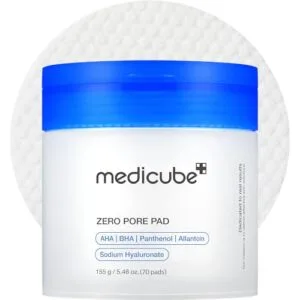 View On Amazon
View On Amazon Skincare meets hair care with this unexpected addition to your routine.
While Medicube Pore Exfoliating Toner Pads target facial pores, they’re worth mentioning for scalp health.
These dual-textured pads contain BHA and AHA acids that gently exfoliate dead skin cells from your scalp, creating a healthier foundation for hair growth.
You’ll use the embossed side first, then the smooth side for absorption.
Though primarily designed for facial use, healthy scalp conditions support stronger hair follicles, which can contribute to fuller-looking hair over time.
Regular exfoliation can also prevent dead skin accumulation that clogs pores.
This process helps maintain a clean and healthy scalp, which is essential for overall hair care.
Best For: Individuals looking to minimize pores, smooth skin texture, and gently exfoliate while managing sensitive or acne-prone skin.
- Dual-sided pads provide effective exfoliation and smoothing in one step.
- Infused with BHA, AHA, and natural ingredients for deep cleansing and skin calming.
- Noticeably reduces pore size, excess sebum, and improves skin texture.
- Slight stickiness post-application may require additional steps like using moisturizer.
- Strong scent may not appeal to everyone.
- Large jar size makes it less convenient for travel.
Gentle Hair Care
Your thin, fine hair requires careful handling to prevent damage while maintaining color vibrancy and volume.
You’ll need to switch to sulfate-free shampoos and lightweight conditioners that won’t weigh down your strands or strip away the protective oils your scalp produces.
Using Gentle Shampoos and Conditioners
Three key factors determine whether your shampoo helps or hurts thin hair.
Gentle cleansing preserves delicate strands while harsh formulas strip essential oils, leaving hair brittle and prone to breakage.
Here’s what to look for in gentle shampoo for thinning hair:
- Sulfate-free benefits – Avoid sodium lauryl sulfate which creates excessive lather but damages fine hair
- Hydrating ingredients – Seek ceramides, glycerin, and natural oils for moisture retention
- Lightweight formulas – Choose products that won’t weigh down already fragile strands
- Scalp sensitivity – Select pH-balanced formulas designed for sensitive scalps
- Fine hair cleansing – Look for volumizing ingredients like biotin and keratin proteins
Your conditioners should focus on mid-lengths and ends, avoiding roots to prevent weighing down thin hair.
Styling Aids for Volume and Texture
Beyond gentle cleansing, you’ll need the right styling products to maximize your thin hair’s potential.
Root lifting mousses create instant lift at your scalp, while texture sprays add grip and body throughout your strands.
These volumizing tools work hand-in-hand with your new hair color, boosting volume where you need it most.
Lightweight formulas can plump strands from within, think of them as your hair’s secret weapon for achieving that fuller look, with the ability to boost volume and provide instant lift.
Minimizing Heat Styling and Over-processing
Heat styling and overprocessing can devastate thin hair, causing irreversible hair damage and breakage.
Heat styling and chemical overprocessing spell disaster for delicate strands—proceed with caution to preserve your hair’s integrity.
Limit blow-drying to medium heat, use protective products before styling, and space coloring sessions eight weeks apart for maximum Coloring Frequency.
Home Coloring Risks include uneven application and chemical burns.
Professional Expertise guarantees proper Heat Damage Prevention techniques, while gentle hair care maintains your hair’s integrity between salon visits.
Before applying heat, consider using a quality protectant product to minimize damage.
Natural Oils and Scalp Protection
Beyond reducing heat damage, your scalp needs protection before color treatments.
Natural oils create a barrier that shields thin hair from harsh chemicals. Your scalp’s natural sebum production decreases with age, making pre-color oil treatments even more valuable for fine hair.
- Argan oil absorbs quickly without weighing down fine strands
- Jojoba oil mimics natural sebum and reduces protein loss
- Grapeseed oil provides lightweight hydration and prevents breakage
- Pre-shampoo treatments remove product buildup while protecting scalp health
Hair Care Maintenance
You’ll need to maintain your newly colored thin hair with specific products and techniques that preserve both color and volume.
Regular trims, volumizing sprays, and specialized styling methods will keep your hair looking fuller while protecting your investment in professional coloring, using methods that help preserve the color.
Regular Trims and Layered Cuts for Volume
Maintaining healthy hair through regular trims prevents split ends from traveling up the strand, which can make thin hair appear even sparser.
Layered cuts create movement and dimension, giving fine hair a thicker and fuller look.
Ask your stylist about volume styling techniques that work with age-related thinning, as strategic layers can disguise problem areas while enhancing your hair texture naturally.
Volumizing Sprays and Mousses for Added Fullness
Besides regular cuts, volumizing sprays and mousses transform thin hair into voluminous hair with the right application techniques.
These products contain lightweight polymers that coat each strand, creating a thicker and fuller look without weighing down fine hair. Unlike volumizing color sprays, these styling aids focus purely on lift and hold strength.
Many users find the perfect volumizing spray thin for their specific needs.
Here’s how to maximize their long-term effects:
- Apply to damp hair – Work mousse through towel-dried strands from mid-length to roots for even distribution and maximum ingredient benefits.
- Use sectioning techniques – Divide hair into small sections when applying spray, ensuring every strand gets coated for maximum volume.
- Compare hold levels – Choose medium-hold products over strong formulas, as thin hair needs lift without stiffness or crunchiness.
- Layer products strategically – Start with volumizing mousse at roots, then add spray to mid-lengths for thorough coverage.
- Time your application – Apply products immediately after washing while cuticles are open, allowing better absorption and longer-lasting results.
Dry Shampoos for Texture and Oil Absorption
Dry shampoos work wonders for thin hair by absorbing excess oil while adding grip and texture.
Application techniques matter—spray six inches from roots, focusing on oily areas. Choose powders over sprays if you have ingredient sensitivity concerns. Travel sizes let you refresh anytime without residue buildup.
Many users find that absorbent ingredients work best for maintaining a clean look.
| Product Type | Best For | Application |
|---|---|---|
| Powder formulas | Fine hair texture | Tap into roots, massage gently |
| Aerosol sprays | Quick coverage | Hold 6 inches away, spray evenly |
| Tinted options | Dark hair colors | Match shade to hair color |
| Volumizing sprays | Lift and body | Focus on crown and part lines |
| Scented varieties | Personal preference | Consider scent longevity |
Hair Fibers for Thicker Hair Appearance
Hair fibers offer an instant solution to make your hair look thick and cover up thin hair scalp visibility.
These keratin-based powders and sprays for thin hair attach electrostatically to existing strands, creating fuller coverage.
When selecting fiber product types, focus on fiber color matching your natural shade.
Proper fiber application tips guarantee fiber longevity while maintaining fiber scalp health for fine hair.
Addressing hair fibers thinning can help maintain a fuller look.
Extensions or Wigs for Severe Thinning Solutions
Sometimes hair fibers aren’t enough when you’re dealing with severe thinning or balding areas.
Hair extensions and wigs offer thorough thin hair solutions that restore confidence and coverage. These custom solutions address significant hair loss with professional results.
Here are five extension types and wig materials to examine:
- Tape-in extensions – Gentle on fragile scalps, these lightweight strips add instant volume without damaging existing strands
- Clip-in pieces – Temporary coverage for special occasions, easily removable and perfect for testing before permanent solutions
- Human hair wigs – Natural-looking full coverage with styling versatility, though cost analysis shows higher initial investment
- Synthetic toppers – Budget-friendly partial coverage for crown thinning, requiring minimal maintenance while protecting scalp health
- Custom hair systems – Professional-grade solutions crafted to your specific hair thinning pattern and lifestyle needs
Frequently Asked Questions (FAQs)
What is the best hair color for thin hair?
Women with thin hair lose about 100 strands daily, making color choice essential.
You’ll want lighter shades like honey blonde or soft caramel that reflect light and create fullness while reducing scalp-to-hair contrast for maximum volume.
How to get a good hair color for thinning hair?
Choose semi-permanent dyes that’re gentler on fragile strands.
Go 1-3 shades lighter than your natural color to reduce scalp contrast.
Add strategic highlights for dimension, and always use bond-protecting formulas to prevent breakage during processing.
How to color thin hair to make it look fuller?
Like painting with light on a canvas, going 1-3 shades lighter than your natural color creates an optical illusion.
You’ll reduce scalp contrast, add warm highlights strategically, and use volumizing dyes that make strands swell for fuller appearance.
How to hide hair color for thinning hair on scalp?
Root touch-up powders and hair fibers instantly camouflage exposed scalp areas. You’ll sprinkle these products directly onto thinning spots, creating immediate coverage that blends seamlessly with your existing hair color.
Is purple a good color for thinning hair?
Purple typically isn’t ideal for thinning hair since it’s a bold, saturated color that can emphasize sparse areas. You’ll want lighter, softer shades that reflect light and create fullness instead.
Should you color fine, thin hair?
You can definitely color fine, thin hair, but choose gentle formulas and lighter shades. Semi-permanent dyes work best since they’re less damaging. Professional application helps prevent over-processing and breakage.
What hair color hides thinning hair best?
Think of light as your secret weapon against thinning hair.
Lighter shades like honey blonde or warm caramel reflect light beautifully, creating the illusion of fuller, thicker hair while minimizing harsh contrast with your scalp.
How to make thin hair look fuller with color?
Choose colors 1-3 shades lighter than your natural tone to reflect light and create fullness.
Add strategic highlights to break up your base color, making hair appear denser while reducing scalp-to-hair contrast, which helps to create fullness.
What is the best haircut for very thin fine hair?
Layered cuts with blunt bangs work best for very thin fine hair.
You’ll want to avoid one-length styles that emphasize sparseness.
Ask your stylist for textured layers that create movement and volume illusion.
How often should I touch up colored thin hair?
While frequent touch-ups seem necessary, you’ll actually damage fragile strands with excessive coloring.
Touch up your roots every 6-8 weeks instead of monthly, using gentle semi-permanent products to preserve your hair’s delicate structure, and remember to avoid excessive coloring.
Conclusion
Studies show that proper hair color selection can make fine hair appear up to 40% thicker to the naked eye.
Finding the right hair color for thin fine hair transforms your appearance dramatically while protecting your strands from damage.
You’ll notice immediate volume improvement when you choose lighter shades that minimize scalp contrast.
Remember to maintain your color with gentle products and regular touch-ups.
Your fine hair deserves strategic coloring that enhances natural thickness rather than exposing thinning areas, and with the right approach, you can achieve a more voluminous look by making informed decisions about your hair color, including the use of regular touch-ups.
- http://www.webmd.com/skin-problems-and-treatments/hair-loss/5-tips-care-for-thinning-hair
- http://hair.allwomenstalk.com/ways-to-hide-thinning-hair
- https://www.vibrantnation.com/fashion-beauty/hair-care/female-hair-thinning-women-use-dye-to-cover-balding-not-their-grey-hair/
- https://www.madison-reed.com/blog/best-hair-dye-for-thinning-hair?srsltid=AfmBOoo7DqwBWMvn6hk2nIhLlwN8wmeV5wdVwz01FFBA5OkqoVOlK77e
- https://www.instagram.com/raylorojohair/?utm_source=ig_embed&ig_rid=dff2f2b0-5078-4e71-b6a1-ba2a7e7e039d

